October 21, 2006
To Pitch Or Not To Pitch, Continued
I've added a lot of reader comments to my commentary earlier this week about the pitching system in TV animation. Almost everybody recognizes that there's something seriously wrong with the system, but what's even more inspiring is to hear how many people are bucking the system and doing their own thing. That should give everybody a lot of hope for the future health of this industry. If you're interested in how this conversation about pitching began, check out this nice summary on Michael Sporn's blog.
October 20, 2006
SMOKIN' TOONS
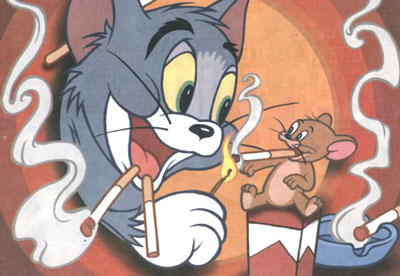
Last month the British press made a stink about cigarette smoking in old Tom & Jerry cartoons. Nicole Hollander even made note of it in her syndicated comic strip Sylvia last Tuesday (excerpt below, see the entire strip here). Now Turner Entertainment is planning to cut those smoking scenes out of all their Tom & Jerry TV prints. Never mind that these cartoons weren't aimed at kids in the first place, and produced in a time when a cigarette, cigar or pipe in your mouth was as common as a cup of Starbucks in your hand today. I've never smoked myself and I am very much against against big tobacco - but I believe it is my right to watch cartoon characters smoke if I want to.
On Saturday October 28th, at the AFI in Hollywood, Asifa Hollywood is hosting a special showing of SMOKIN' TOONS. A special blend of cartoons from the 1940s and 50s, hosted by yours truly Jerry Beck, will screen at 3pm. No smoking permited on the AFI campus, but I guarantee your lungs will ache with laughter! Join us!
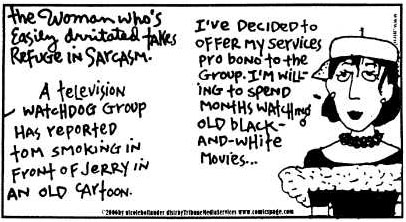
(Thanks, Alex Rannie)
2D OR NOT 2D

Roy Disney will be one of the guest speakers at the 2D OR NOT 2D animation event in Everett, Washington, next month. This new animation festival hopes to revive interest in hand drawn animation with a series of screenings and lectures over a three day period. Roy Disney will present a screening of Disney short films from the past 75 years. Animator, author and festival organizer Tony White will screen ENDANGERED SPECIES, his new short film. Animator Nancy Beiman will discuss her new book, Prepare to Board, and show excerpts from films she's worked on. Cartoonist Tom Wilson will show ZIGGY'S GIFT, and there are screenings of the restored 1955 feature film ANIMAL FARM, DREAM ON SILLY DREAMER and several other surprises.
2D OR NOT 2D Animated Film Festival will be held at the Historic Everett Theatre in Everett, Washington from November 17th thru 19th 2006. Check the website for more details.
PARADE OF MONKEYS

Talk about personal vision. Freelance animator/illustrator Mike Owens has been working for over a year on an unusual personal film, a multi-screen, multi-media animated project entitled Parade Of Monkeys.
My goal for this film is to project the animation on multiple screens in a theatrical setting, mixed with live performance, lighting fx and live music.Sounds cool to me. Check his production blog for art, updates and pencil tests.
AH
Another beautiful and amazing student film from France's Supinfocom. Also check out the official website.
October 19, 2006
COOL WORLD Boards by Louise Zingarelli
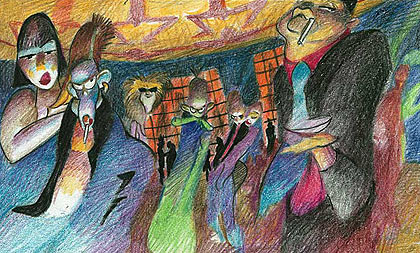
The ASIFA-Hollywood Animation Archive's Steve Worth has posted a collection of beautifully drawn pencil and Prismacolor storyboards created by the late Louise Zingarelli for the feature COOL WORLD. The artwork is accompanied by personal memories of Zingarelli and her career. Well worth checking out.
UPDATE: Animator Mike Kazaleh emailed these memories of Louise Zingarelli:
I saw your link on the Brew to Steve Worth's ASIFA post about Louise, and it brought back memories. I had worked with Louise Zingarelli on "Tattertown", "The Butter Battle Book", and "Cool World". Meeting Louise was like finding a long lost sister. She was a lovely person and a tremendous talent. I remember on Cool World she was often flustered at the fact that many people on the staff didn't "get" the designs for the girls. She had exaggerated the girls' figures in all her drawings, but the combination of the fact that rotoscope was used, and the fact that several of the animators were very literal minded, the cartoony exaggeration never made it to the screen. I remember there was one guy in particular who was some kind of Milt Kahl wannabe. Louise and I watched a pencil test of his first scene of Holly, and we were horrified to see that he had drawn her with LONG, SQUARE, FLOPPY HANDS! We had an assistant fix it before Ralph saw it. Maybe we shoulda let him see it.
COMMENTARY: To Pitch Or Not To Pitch?
A few weeks ago, I commended New York animator Pat Smith for making this comment in an ANIMATION WORLD MAGAZINE interview:
"The pitching system is a bad system though it works for a lot of people...I see many talented artists working very hard pitching shows all the time. If they funneled that kind of energy toward making a film, they might have a little something more to show for it."
David Levy, president of ASIFA-East, didn't agree with Pat's original statement or my subsequent praise of it, and he wrote an op-ed in the ASIFA-East newsletter explaining the benefits of pitching. His piece, which I recommend reading first, can be found here. The gist of the commentary is the following: "If someone's ultimate goal is to helm his or her own series creation, then the way to do that is to write, create, and pitch as often as possible. That is how one develops those muscles."
I wholeheartedly agree with Levy's first two suggestions of things a young artist must do regularly—writing and creating. However, his recommendation to pitch as often as possible is where we must respectfully part ways. Pitching, in my opinion, is one of the most creatively destructive and degrading activities that a developing artist can engage in, and continual pitching is a surefire way to guarantee that you never make great TV animation.
In his article, Levy maintains that pitching frequently is a positive thing; he offers this justification: "So too, does a would-be TV series creator serve his or her purpose by working other's TV productions, pitching as often as they can, and fostering their own reputations to ready themselves for the moment when their creations connect with an executive." But in that sentence, Levy pinpoints exactly what is wrong with today's TV animation industry: television creators who come up through the system learn how to connect exclusively with executives. Connecting with an executive, however, is hardly the same as connecting with an audience. Television animation suffers today largely because too many creators have a skewed sense of priorities and believe that satisfying execs (who most often don't even understand the medium) is more important than satisfying audiences.
People often wonder why cartoons were so much more entertaining during animation's Golden Age. Perhaps because back then filmmakers were given the freedom to communicate directly with audiences without creative filters who altered their work before it reached its intended audience. The great Golden Age directors like Jones, Freleng, Clampett, Avery, Hanna, Barbera, Hubley, Tashlin, Cannon, McKimson, Burness, Harman and Ising were trusted by their superiors and allowed to create animated shorts as they saw fit. The resulting cartoons were not just successful in their own time but still entertain audiences half a century later.
Today, it is impossible for artists working in TV animation to express themselves creatively in the direct fashion of those earlier directors because of processes like pitching, development and focus grouping, which have all been rendered useless thanks to years of misuse and abuse by executives. The pitching process itself, which was once a beneficial collaborative exercise used between artists to make ideas stronger, has been subverted into a mechanism that exists only to allow executives an entry point into the creative process.
If ever there was an argument against the backwardness of contemporary TV animation development, one simply needs to turn on the television. Regardless of network, there is a sameness of product across the board, a striking lack of vision, a virtual absence of appealing and engaging characters, a consistently bland execution of concepts, and a general gutlessness in the majority of TV animation. Animation producers wisely don't make their development process public, but in the rare instances that they allow audiences a window into how they develop ideas, like the Disney Channel's recent series of Shorty McShorts' Shorts, the results are comically and embarrassingly awful. It also makes painfully evident how detached the pitching and development process is from the reality of what audiences actually want from cartoons. A clue: it sure as hell isn't this or this.
While today's TV animation development process doesn't offer the same opportunities for creators to develop their artistic voices as in animation's Golden Age, there are ways to circumvent the process. The best option is to develop your chops outside of the industry before attempting to pitch your own television series. Take, for example, the creator of one of the most successful cartoons of the past decade: SPONGEBOB SQUAREPANTS. Stephen Hillenburg was nearly thirty years old before he even started working in the industry. Prior to that, he had studied marine biology, taught kids, and studied experimental animation at CalArts—hardly the resume of your average TV series creator.
True, Hillenburg spent a number of years working on other TV series. It would be naive to believe that one shouldn't have industry experience before creating their own show. Rather my suggestion is that one should enter the industry only after they have matured creatively and developed an artistic voice independent of influence from TV executives. I don't think I need to mention that the longest-running animated series of all-time—THE SIMPSONS—also has a creator who came into the industry after he knew what he wanted to say. In Matt Groening's case though, he didn't have anything to say visually and he has used his opportunity to express an almost exclusively verbal vision.
All this leads back to my original thought in which I applauded Pat Smith's comment that artists should spend more time creating independent shorts instead of TV pitches. Independent shorts teach potential TV show creators a priceless lesson: how to communicate directly with audiences instead of with executives. Just as importantly, independent shorts allow a filmmaker to prove that their vision works with audiences (take for example Trey Parker and Matt Stone's short THE SPIRIT OF CHRISTMAS). And with a proven success (or successes), the filmmaker gains greater leverage in maintaining their vision throughout the TV production process. It's a longer, but ultimately more creatively rewarding, road.
The encouraging news is that more and more of today's talented artists are coming to this same conclusion and finding that there are ways to work in the industry simultaneous with developing a personal approach through independent short-form projects. Some of the artists pursuing this path include Pat Smith, Chris Harding, Seamus Walsh & Mark Caballero, Gregg & Evan Spiridellis, Nick Cross, Guilherme Marcondes and Joel Trussell. There's no reason or excuse for toiling helplessly within a system that is clearly broken, and it's encouraging that artists are increasingly recognizing the futility of the TV animation development process. I strongly believe that the ranks of these artists will continue to grow over the coming years and ultimately that means better TV cartoons for everybody.
Your thoughts? Email to amid (at) animationblast (dot) com. (Please indicate whether I can post your thoughts and whether you want your name included or prefer to remain anonymous.)
Responses to "Pitch or Not To Pitch?"
Lots of people are writing in with ideas of their own. Here's a selection:
Character designer and show creator Bob Harper writes:
In regards of whether to pitch or not to pitch, I feel that you and Pat have valid concerns and arguments as does Dave. I do not think that pitching constantly for the sake of pitching is worth while. One could get a reputation of creating dud after dud and seem pesky. However, if your goal is to create a TV series, at some point you do have to pitch, and practice does make perfect.I have worked in the industry for a few years now. I have developed some relationships with execs as well as other creators and artists. Considering the buyers are the execs, it is important to create a good relationship with as many as you can. The emphasis is "GOOD". In my opinion most execs don't want to see pitch after pitch from the same creator, who seems to throw everything out there. It is important to pitch something you have spent time on, and love.
I have thought about the "shorts" route, and may make some soon. I need it to be financially viable for my efforts. I have a family to feed and unfortunately making bucks off shorts is as tough as turning lead to gold. Since I have limited time and resources, I create projects that I think are "saleable". I only create something that I want to watch and think an audience wants to watch. I have pitched only about six projects over the past 3 years, only because those were the ones I believe in. It's paid off since I have now been optioned, and the process went and is going smoothly.
I do agree that making a feature is a way of going, and still is something I am pursuing in my spare time. The energy in creating pitches could be use to write a screenplay, which is a commodity to sale. Then in one's spare time, board it design it etc. and before you know it , your preproduction is done. Now you have an opportunity to co-produce with a studio. And in the end animate it if need be like Bill Plympton and Phill Nibblenik have proven can be done. The final trick is to find distribution, which is tough but more possible once you have a product and it is good.
The points I agree with most is to continue to write, draw create and as you pointed out, find your voice - that will be the difference in creating and selling a cartoon that lasts a long time versus a thrown together run of the mill show, that people will soon forget.
Ottawa International Animation Festival artistic director Chris Robinson writes:
This obsession animators have with getting a tv series drives me crazy. Why is it your goal to have a tv series? Who said animation has to have regular characters, actors, and narratives? Your mommy? I see how it influences and ruins so many short films we receive at the OIAF because these works have not one ounce of personality, they are projects made to try to appease the desires/wants/needs of what they think SOMEONE ELSE wants...they are not making art, they are seeking markets to fit into. And look...I'm not against tv..but the best tv shows were NOT made to fit in..they were works that were fresh, new (just look at Seinfeld, The Office, most HBO shows etc..).Look, if you're an artist...it means you feel you've got something to say. You should just say it and not worry about whether it's what some twit in an office wants. I totally agree with Pat that you should spend that energy on SAYING that thing you've apparently got to say and not worrying about getting a damn tv show (of course, the reality is that if many of you stopped to think about it, you'd realize that you aint got nothing to say).
This myopia that inflicts so many animators is ridiculous and it's what keeps this art form locked in the cellar of the half-brains.
I'd even go one step further than Pat. Put this energy into your CONCEPT first (ie. do you have something to say?) If you aint bursting in the head to get this idea/feeling/concept/whatever out of your system...then move on until you do find something that gives you such an intense chill/flush/buzz/rush that you can't stop till you get it out...like taking a big shit. THAT's what art is kids.
Animation director and show creator Mark Mayerson has a blog post HERE where he describes his experience in television series creation and why he won't be doing it again.
Toronto-based animator and director Blair Kitchen has a blog post about the importance of investing in one's own ideas. He writes: "For some strange reason, so many artists are horrified at the thought of investing in their own ideas. They feel like they need someone with money to tell them that it is OK for them to carry on with their vision. They complain that no one will invest their money in their idea, when they aren’t even willing to invest in it themselves. I don’t get it."
Animation producer and ASIFA-Hollywood Animation Archive director Steve Worth shared these thoughts on Michael Sporn's blog:
Executives don’t make cartoons. Animators do. Part of the reason TV animation is so messed up is because animators have allowed networks and executives to take over job functions that properly belong with creators and directors. Pointing out the idiocy of executive interference isn’t dwelling on something that we’re not in a position to control, it’s pointing out a blatant error in the production system that is compromising the quality of animation.I don’t know a single animation pro who doesn’t have “war stories” involving the boneheaded notes they’ve received from executives. I have a few thousand myself. Amid isn’t oversimplifying the situation, he’s pointing out the emperor’s nakedness. This is a serious situation, and it’s not going to change unless the backwardness of the process is exposed to light and revealed for what it is.
Joe Barbera described a pitch that he gave to Fred Quimby in an interview I read. He said that he sat down with Quimby all excited about the story… “See, the cat runs around the corner, and the mouse is there with a hammer…” He’s acting it out and hamming it up. Quimby has a far away look in his eye and says, “You know what? Nixon is a horse’s ass…” Barbera stopped dead in his pitch, and Quimby repeated it… “Yeah, that Nixon is a horse’s ass…” Barbera said that was the last time he pitched to Quimby. From then on, he only worried about pleasing his audience.
We need more Quimbys and less meddling wannabe “creative” executives. And animators need to worry about pleasing audiences, not the whims of people who are unqualified to have an opinion.
ASIFA-East president David Levy offers these additional thoughts:
Great discussion everyone! I whole heartedly agree that no one should pitch for pitching sake. You've got to have real passion and believe in each idea to present it in a pitch meeting. Otherwise you've wasted everyone's time, including your own. It comes down to how you define success. I've not sold a TV pilot idea to date, although I've pitched an average of twice a year since 1999. Yet, each attempt helped me zone in on the craft and skill of how to best organize and present my ideas. I've made great relationships with some development excecutives I clicked with and met some I would not care to pitch again. Pitching is not only shopping your idea for a network to buy, it's also discovering which network/exec is the best fit for you.Amid, you point out how independent projects (free of developoment exec tampering) have led to some great success stories (as in the case with South Park). There are opposite examples I can point out in which independent filmmakers were given pilots and they were big bombs. In two cases I'm thinking of, the creator, who is a top indy filmmaker that specialized in song-driven indy cartoons, could not handle the dynamics of a story-character driven vehicle with dialogue. It proved to be no secret as to why the indy filmmaker's work was song-driven in that it was their strong suit and they couldn't easily bridge the gap to create something character driven.
I find it comical that, in a sense, I am defending the pitching and development process. I have been deeply frustrated by this process and those that have read my book (Your Career in Animation) can bear witness. But, I think that in the end, we are all saying the same thing. Which path do you want? What are your goals? Nuturing your voice in independent films is a wonderful thing, but it doesn't make an automatic best path towards readying yourself to create and helm a series. Nor does creating, pitching, and cutting your teeth on series TV automatically mean you can create sellable or good TV product. Why speak in absolutes?
Storyboard artist Louie del Carmen responds to my commentary with some thoughts of his own on his BLOG. An excerpt:
Here is an exact quote to me from a studio exec whom I pitched to (i'll spare this person the embarrasment by leaving them nameless): "What I like about your show is what I hate about it" I've since tried and given up trying to even make any sense of that.
Animator Keith Lango also posts on his BLOG about his poor pitching experiences with studios. His bottomline: "I'd rather make something that I enjoy than something that is merely a vehicle for some corporate media-employee to get a promotion. So I weigh in on the side of the 'pitching to TV networks is a big waste of time and effort' in this debate."
Vancouver Film School student Corey McDaniel has a unique take on the matter:
I'm a student at Vancouver Film School's classical animation program. I have been throwing around the idea to my instructors that I want to pitch show ideas to networks once I get done with school. The reactions have been all positive for the most part but it feels like at the same time I'm being warned by a blind, weary old traveler not to enter the dark wood for death awaits me with nasty big pointy teeth.I just thought I would offer my little (probably naive) opinion on the matter. VFS's classical animation program is dwindling. Since I arrived here last January, less and less people are signing up for the program. There are 2 empty rooms on our floor now and the program is being reduced to only 3 classes per year as opposed to 6. The president of the program left seemingly out of nowhere. It really feels like as I've discussed with my classmates that 2d is going down the shitter and fast. Your post feels like a wake up call to any senior or newbie animators to stop trying to fall in line and start doing things your own way. Despite the state of things I really feel like there is going to be some sort of second renaissance in 2d (or any other form) of animation.
Anyway thanks for the post, it has gotten me thinking that there are better ways to go about expressing my ideas to an audience. I think everyone with a passion for animation and creation should attempt to go this route, who knows it could spark something really big.
Show creator Steve Schnier (FREAKY STORIES) gives this perspective:
As I wrote in the comments on Mark Mayerson's blog—my experiences pitching have been mostly very positive. I've created, pitched and sold a show and continue to pitch new shows. The series got on the air was very similar to my original concept—and the changes that were "imposed" on me, were I honestly feel, mostly improvements.
I've developed a philosophy that helps me in dealing with "suggestions" from outside sources, e.g. executives and other experts: If I don't like the suggestion, I ignore it and hope it goes away. If I do like the suggestion, I simply take credit for it.
Pitching and development, for me, is done in the hope that I can better myself—that there is "more" to this biz than what I am doing today. There's a chance to do something for myself (artistically) and for my family (financially).
British animation artist Jamie Badminton writes:
In response to Chris Robinson particularly, I feel that if an artist has something meaningful to say, a TV series is potentially the ultimate way to communicate those ideas to an audience. If you can create a cast of characters that viewers start connecting with every week, in theory, it is soon possible to delve deeper and explore their humanesque complexities and begin to tell rich, meaningful tales. As a child especially, you start relating to your favourite familiar characters in the way you care and listen to your best friends; if, as a creator, you lead those characters through a meaningful life-altering experience (however small it may seem from an adult P.O.V.) it will undoubtedly resonate more strongly with the audience than a one-shot story ever could.The problem is with networks more than ever wanting animated shows where each episode begins and ends in the same place in time (for whatever financial reasons). They are limiting the opportunities for creators to properly flex their storytelling muscles. The pattern of real life doesn't fit into that mould, so it's no surprise that stories created in that way will, more often than not, be wholly derivative. Shows like Avatar and other shining lights do occasionally manage to break through those barriers, but whilst pitchers are still being encouraged to think within such small, formulaic boxes to match a pre-conceived notion of what an executive may think they want, artists will always find themselves going round in circles.
As a young animation artist trying to get my foot in the door, I've already had my share of frustrating professional experiences where I've witnessed creative spirits being crushed. My writing partner and I have tried and do just what other people here have suggested; we're side-stepping slightly and have managed to make our 'pilot' in the form of a self-published, heavily illustrated storybook that we can deliver straight to our audience (in this case, a horse adventure to the equestrian market). It's been tough to stay afloat whilst producing it, but so wonderfully exhilarating to follow through on the story we wanted to tell from start to finish without any interference. We've already managed to sell 300 books to kids and their parents at our very first horse show, and when you get a genuine email response from a random 8 year-old girl through your website saying she 'read it all the following day and it was brilliant, and she's 'looking forward to the next book to find out what happens...,' all the personal financial risks over the last eighteen months suddenly start to seem worth it. Obviously, I still have to hope that people with power will like the finished products enough to keep trusting us towards television and other plans, but I feel the confidence alone I've gained after achieving this first rung has got me half the way there already.
Animation fan Ed Thompson writes:
I am writing to offer my views on this subject, which comes from a different perspective than most of the replies that you have already posted. I am not involved in any aspect of the animation business myself, so I have no experience with having to pitch an idea and no personal stories (good or bad) to tell. I am just a cartoon fan.If I understand Mr. Levy, he is saying that the process of having to sell an idea makes animators and animations better by forcing you to hone an idea or concept and present it to someone who has a choice of many presentations and can pick and choose the best. If this is so, where are these better cartoons? Can he cite examples where a cartoon went through this process and a superior product was the result? Does Pixar work by this method? Does he believe that the Simpsons/Family Guy/King of the Hill are showcases for what this system does? Or are there other shows he thinks better exemplify the 'pitch' concept.
In my own opinion, as someone who does not make a living off of animation, but instead is part of the intended audience, the past three decades have been a period of decline and mediocrity. I am not saying that nothing good has been made, but for a supposedly better way of selecting what gets made and what doesn't, there seems to have been a much smaller number of exceptional or even good commercial animation made when compared to any time since the late 1920s. And finally, isn't this the same system which is producing such films in the live-action medium such as 'Starsky and Hutch', 'Dukes of Hazzard', and 'Son of the Mask'? I don't think the system works very well in non-animation films or shows either.
British animation artist Jim Bending writes:
I'm in total agreement with you. David Cantollo, co-creator of Pocoyo, had a terrible struggle during the pitching stage. The executives wanted to get rid of Pato the duck for example. He describes it here and here. David wrote: "We really didn’t like these meetings. Not because we didn’t have a good relationship with them (although we weren’t the best of friends either) but it was basically because we had nothing in common … we were like night and day. We didn’t understand each other at all. The meetings were really dull, no smiling, they simply wanted a different series to us."The major thing that struck me about David Levy's original commentary was this statement: "Another distinction I see between the independent path and the TV series path is the affinity one has either towards character vehicles (as in TV series) or concept/story driven films (as in most indy films). An independent film may focus on the changing seasons on a farm and handle it in a most poetic and abstract way."
I believe that independent film create the most believeable characters, particularly Micheal Dudok De Wit. He created the character 'Tom Sweep' a funny little short about a frustrated rubbish man. After Monk and the Fish (another character driven animation) he won an Oscar for 'Father and Daughter' a beautiful film about a lost relationship. Obviously you wouldn't have a series of 'Father and Daughter' but he would be ideal for transferring his skills to other commercial projects.
Animation veteran John Halfpenny writes:
It seems to me, that laying the blame for all this on some bone-headed executives is missing the point. Animation history is littered with cycles of creative flight bottomed out by low budgets and tight schedules. My own animation "career" has been a checkerboard of swearing off television, only to be drawn back in when the time was right. Yes, it is true that original vision can only be gained by working on your own projects. Whenever I leave the business, I work on developing some new aspect of my artistic equipment. I've spent time pursuing illustration, live action and music. Inevitably though, I will always be drawn back into animation. It's what I do. Just not when there's a conservative government in power.Why are we all so dogmatic? Many animators only respond to ersatz Disney posing or fall in love with the line tool. Many writers choose to have different characters all speak with only one voice, their own. Many directors see the screen as a proscenium instead of engaging with the world they have built. Many executives cry about the sameness of the pitches they receive and greenlight the same shows again and again. We piss and moan about the shows that get made because this is a business built on ego.
To suggest that making a personal film is the antidote to this problem is naive, if you expect the world to respond. The festival circuit has a set of ground rules just as doctrinaire as television, because juries are just like us. The animation world has its head up its ass. Just like the real world. Let's all stop pointing fingers and try to relax. It's great to make a personal film. It's great to work with a group.
I have pitched before. I'm sure I will pitch again. My pitches will stand a better chance, I believe, when ears and minds are open. I'll wait.
October 18, 2006
HORNSWIGGLE PAINTED
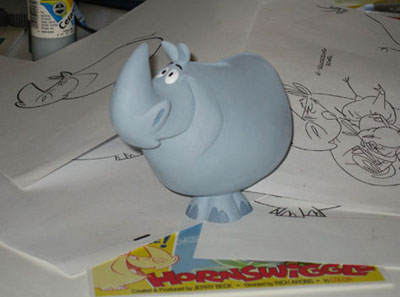
Time for another update from animator/sculptor Jason Peltz who sends us the first image (above) of the painted Hornswiggle maquette he is working on. It's really looking good and I'm delighted that Jason has agreed to create a small number of the them so I can offer several for sale. I have a small waiting list of readers interested in getting one of these limited edition maquettes. If you'd like to be on that list drop me a line at jbeck6540-at-aol.com. The price will be $75. and Jason says he'll have them ready to ship the week of November 1st. Another update next week.
AZUR AND ASMAR

The latest film from director Michel Ocelot (Kirikou) called Azur et Asmar will open in France next Wednesday, October 25th. Looks like a mix of 2D cut-out style animation and 3D. It'll certainly be worth checking it out. But as usual, no U.S. release is planned. Here's the trailer and the synopsis.
(Thanks, Sean Dicken)
BLUE SKY BLOG JAM
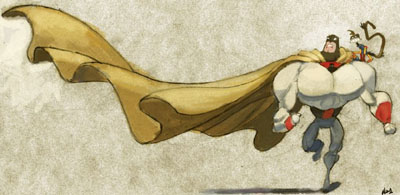
It's a shame the latest Scrat short was removed from GoogleVideo yesterday, but today the Blue Sky artists have another treat for us. Check out the Blue Sky Studios Challenge, a new joint artists blog. Artist Jake Parker explains:
Some of us at the studio are actively participating in our own little jam blog. Every week we set a topic and then everyone does their take on it. It's open to the whole studio so sometimes you get designers, and other times you get production assistants contributing. For the most part it's Animators, story artists and designers who participate.Man, this is fun. Check their SpongBob challenge and the Pixar character challenge (and wouldn't it be great to see Pixar artists take on the Blue Sky characters). The images above and below are from the favorite 1980s TV characters challenge. Beautiful work.
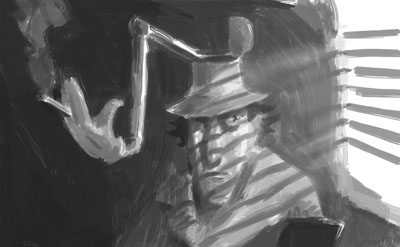
HAIR HIGH PREMIERES IN NYC TONIGHT
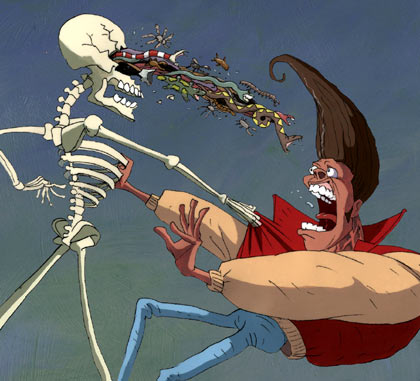
At long last, Bill Plympton's latest animated feature HAIR HIGH premieres tonight in New York City. It is screening for one week (Oct. 18-25) at the Two Boots Pioneer Theater (155 East 3rd St, between Ave A&B). This is, in my opinion, Plympton's strongest animated film to date, featuring a compelling narrative in addition to loads of great laugh-out-loud visual gags. The film is difficult to describe though this synopsis does a pretty good job: "An outrageous Gothic myth from the 1950's, HAIR HIGH is the legend of a teenage couple murdered on prom night who return as undead skeletons one year later for revenge. The film is a unique romantic comedy with a zombie-horror twist." Plympton makes the idea work and he makes it work well.
Every guest at the premiere tonight will receive a drawing from Bill, and he'll be making additional appearances at the theater throughout the week. Cast members and other guests (including the "Krazy Kock" chicken mascot) will also appear at the premiere. Online tickets can be pre-ordered HERE. The official film website can be found at HairHigh.com.
THE NIGHTMARE IN 3-D

The other night I had a chance to screen the 3-D version of Tim Burton's The Nightmare Before Christmas. All things considered, the folks at ILM who converted the film (which was not shot in 3-D in the first place) did a pretty good job. And since it wasn't designed for 3-D there weren't many opportunities to have things go deep into the background or pop off the screen, but the effect holds up pretty well throughout the picture. A new introductory countdown piece (featuring a pumpkinhead jack-in-the-box) is the best 3-D gag in the picture. The new Walt Disney Pictures logo looks pretty cool in three dimensions too. This online featurette tries to explain what they did to achieve the new 3-D effects.
The original Henry Selick film was always a lot of fun (and let's not forget Joe Ranft's important contributions to the story) - and Danny Elfman's operatic score is one his greatest achievements. A new Special Edition soundtrack album (I snagged a freebie at the screening) contains Danny's original demo tracks and some great covers by Fionna Apple (Sally's Song), Marilyn Manson (This Is Halloween) and Fall Out Boy (What's This?).
The new Nightmare opens in theaters this Friday, October 20, along with Pixar's 3-D short Knick Knack.
MERRITT & KAUFMAN'S SILLY SYMPHONIES BOOK

Here's a book I can't wait to have and hold (and read!). Russell Merritt and J.B. Kaufman have been researching the history of Disney's Silly Symphonies for a decade. This year, in conjunction with a screening at the Pordenone Silent Film Festival (held last week), the book has finally been published. However, I have no idea how to order a copy or from where. In the meantime, we can whet our appetities by reading Merritt and Kaufman's film notes for their Pordenone presentation, and this essay they wrote for the on-line Walt Disney Family Museum.
October 17, 2006
TOWER 8
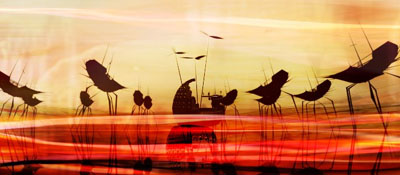
Artist, illustrator and flash animator Danny Cannizzaro has spent the last year working on a new project, Tower 8.
Tower 8 is a growing online narrative that's told through a series of experimental animations by myself and other directors, centered on the idea that in the future, the earth has undergone major change: its natural resources are near depleted, the oceans have receded and creativity has become a physical force. As of right now we just have the first video up, about a city that has a band as its army that it sends out to defend itself.It's a good looking, ambitious piece of work. Danny and his partners, Gavin Brown and Ashtnmike, have also set up a production blog to update its ongoing progress.
October 16, 2006
THE MERRY CIRCUS
Slow day at the Brew. So here's a lovely animated short, courtesy of YouTube, by the celebrated Czech filmmaker Jiri Trnka. It's The Merry Circus (1951). Although Trnka is well-known for his puppet films, this piece uses cut-out animation and has a lovely picture-book illustration style to it.
It's split into two parts - part one is below. Part two is here: The Merry Circus - Part 2
This and many other great Jiri Trinka films are available on DVD.
(Thanks, Firoz Hussain)
October 15, 2006
NOTHING LIKE THIS
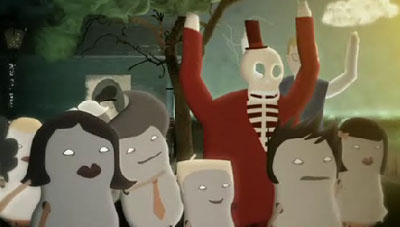
Okay, check out this cool music video based on a track by the late hip-hop producer J Dilla. Nothing Like This was produced by Brooklyn based Mixtape Club for Producer/Director Daniel Garcia (sample his incredible work here) for Adult Swim and Stones Throw Records, as part of a mixed media project called Chrome Children. Two other animated videos directed by Garcia will be posted soon on the Adult Swim site. For more information on Chrome Children go here.
(Thanks, Delirio & Kaos)
OFF THE MARK
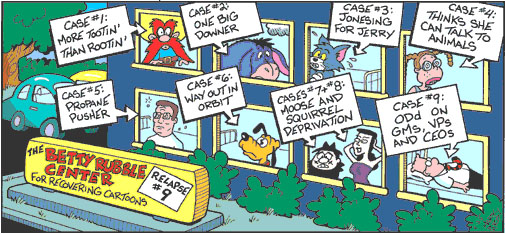
Mark Parisi started self syndicating his comic panel Off The Mark in 1987. In 2002 the strip went big time when United Media took it on and since then it's been nominated for Best Newspaper Comic Panel by the National Cartoonists Society. Like other cartoonists, Parisi has occasionally poked fun at established comic strip and animated characters. His cartoons about cartoons are quite funny - and thanks to his search engine, you can see all of those strips collected here.
CG TOM & JERRY SPOT
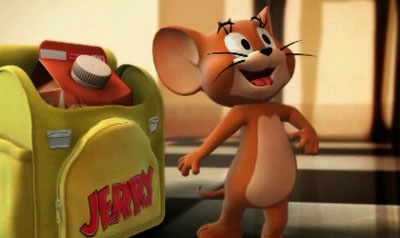
Did you hear the one about the Tom and Jerry commercial in CG...
...selling a flavored milk drink...
...in hebrew? Click Here. Oy Vey!